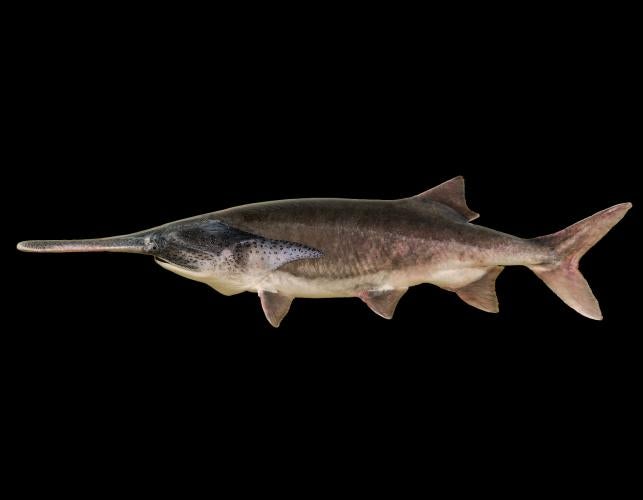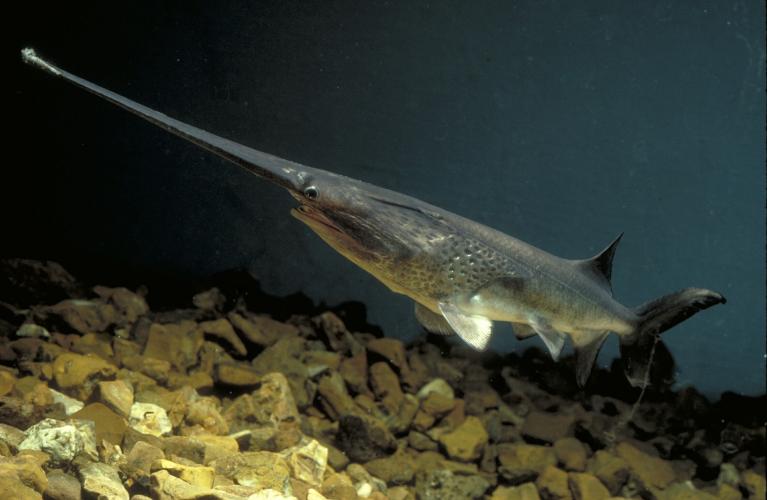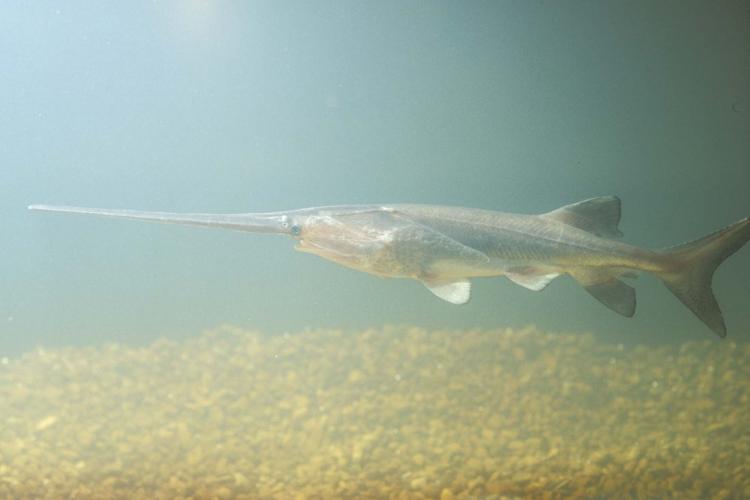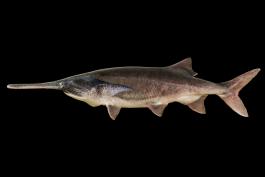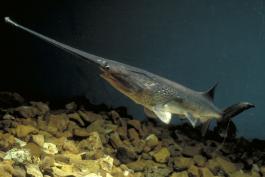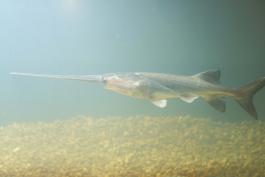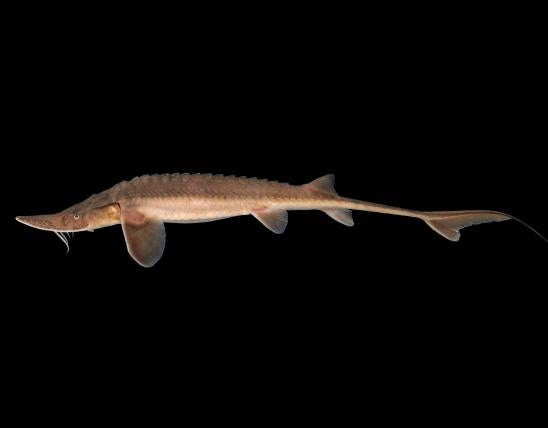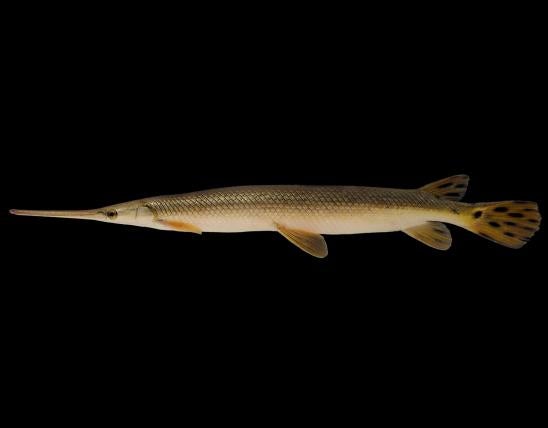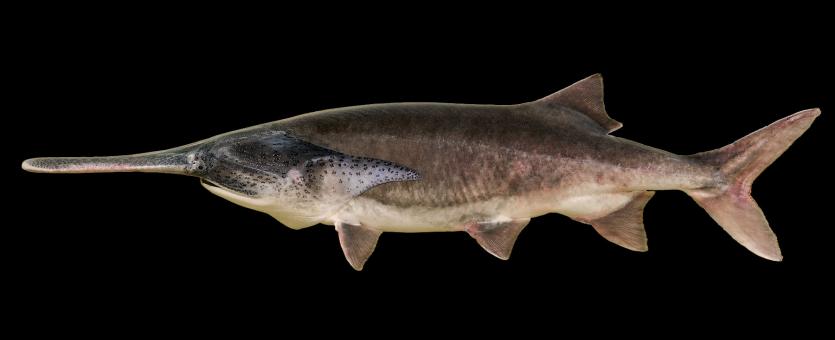
The paddlefish is sharklike, with a greatly elongated, paddlelike snout. Overall color is bluish gray to blackish on the back, grading to white on belly. The snout in small individuals is more one-third of the fish’s total length. The mouth is large, lacks teeth (in adults), and is far back beneath the head. The eyes are small, positioned just above the front edge of the mouth, and directed down and forward instead of to the side. The gill cover has a fleshy, pointed flap. The tail is forked, with the upper lobe longer than the lower. There are no scales, except for a patch on the tail.
Similar species: The paddlefish's only living relative, the Chinese paddlefish, was officially declared extinct in 2022. That leaves our paddlefish the only living representative of its unique lineage left on Earth.
Length: to about 7 feet; weight: to 160 pounds or more.

Historically found in the Mississippi, Missouri, and Osage rivers, and other streams; now stocked in impoundments.
Habitat and Conservation
Paddlefish live mostly in open waters of big rivers, swimming continuously near the surface, and likely don’t have a specific home range. As waters rise in spring, paddlefish move upstream to gravel bars to spawn. Because they need lots of open, free-flowing rivers plus oxbows and backwaters for feeding and gravel bars for spawning, paddlefish numbers have declined with stream channelization, levee construction, and drainage of bottomlands. Dams prevent paddlefish from being able to move upstream to their spawning territories, which prevents them from reproducing on their own. Thus they rely on artificial propagation (human-run fish hatcheries) to maintain their species.
Overharvesting has also contributed to their decline; illegal poaching and trafficking also contributes to declining populations. In regions with large infestations of the invasive zebra mussel, those mussels filter significant amounts of plankton out of the water, plankton that would otherwise feed native paddlefish.
Food
Paddlefish swim slowly through water with their mouths wide open, collecting tiny crustaceans and insects in their elaborate, closely set gill rakers. The paddlefish's paddle (rostrum) apparently functions as an electrosensory organ, allowing it to sense the presence of plankton as it swims through water.
Status
Channelization, damming, impoundments, and other river modifications have greatly diminished the habitat for this fish. Impoundments hold the highest populations of paddlefish today, but because many of these lack feeder rivers that meet the fish’s exacting spawning needs, these populations are not self-sustaining and must be stocked.
The paddlefish is Missouri’s officially designated aquatic animal.
The paddlefish is the only member of its family left on planet Earth.
Life Cycle
Spawning occurs in late spring at times of high water; eggs are deposited on silt-free gravel bars where, during regular water levels, they would be exposed to air or are covered by very shallow water. The eggs hatch and the larval fish are swept downstream to deeper pools where they grow to adulthood. Paddlefish can attain a length of 10 to 14 inches their first year, and at age 17 can be 60 inches long. Paddlefish can live to be 30 years old or more.
Human Connections
Missouri’s official state aquatic animal, the paddlefish is highly valued as a sport fish. It is valued for its flesh as well as for its caviar.
Because it is one of the most ancestral fish species alive today, it is of considerable interest to biological research.
Because Russians and many other people all over the world love caviar, farming of American paddlefish occurs in many places in the world. American paddlefish are stocked in rivers in Europe and Asia. Captive breeding programs exist in the Ukraine, Germany, Austria, the Czech Republic, Bulgaria, China, Russia, and Cuba.
Ecosystem Connections
The constant grazing of these fish on tiny aquatic organisms helps to keep their populations in check; paddlefish and their eggs and fry provide food for other aquatic predators.
Sadly, the paddlefish's closest relative, the Chinese paddlefish, has recently been declared extinct. It was native to the Yangtze and Yellow River systems in China (huge rivers that are similar to our Mississippi and Missouri rivers). Like salmon, adults of that species needed to be able to move from the sea upstream into freshwater to spawn. Dams on the rivers prevented them from doing this, just as dams prevent our paddlefish from moving up and down stream channels. Overfishing harmed populations, too. Its average length was nearly 10 feet. As late as the 1970s, annual harvest of the Chinese paddlefish was 25 tons. Attempts to propagate the species artificially (as we do with North America's paddlefish) were unsuccessful. No one has seen a living Chinese paddlefish since 2003. Unlike our plankton-feeding paddlefish, the Chinese paddlefish was a fish-eater.
In addition to our paddlefish, only five other species of paddlefishes are known: One is the recently extinct Chinese paddlefish. The other four disappeared long, long ago and are known only from fossil evidence. The Polyodontidae family of fish goes back to the Early Cretaceous, 120 to 125 million years ago, about the same time that flowering plants (angiosperms) appeared on Earth. It would not be inaccurate to think of paddlefish as "living fossils."
